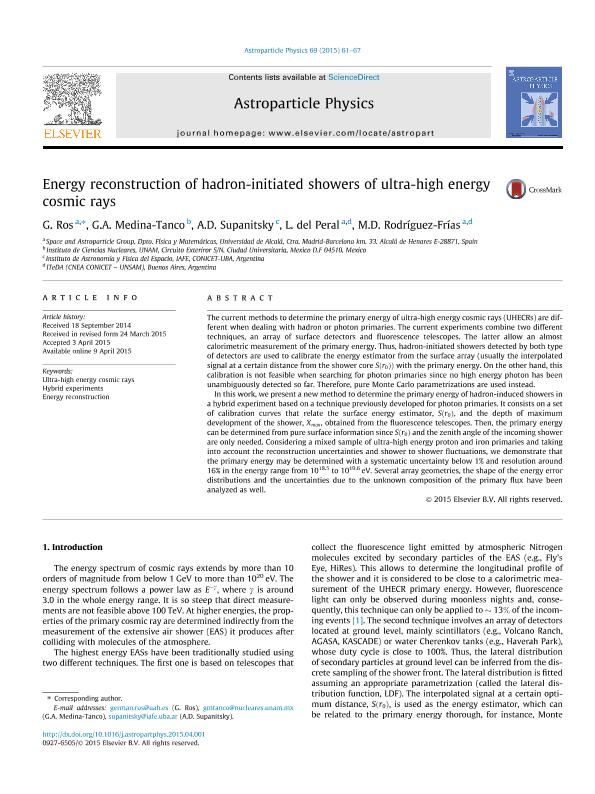Mostrar el registro sencillo del ítem
dc.contributor.author
Ros, G.
dc.contributor.author
Medina Tanco, Gustavo Adolfo

dc.contributor.author
Supanitsky, Alberto Daniel

dc.contributor.author
del Peral, L.
dc.contributor.author
Rodríguez Frías, M. D.
dc.date.available
2017-06-06T18:51:54Z
dc.date.issued
2015-04
dc.identifier.citation
Ros, G.; Medina Tanco, Gustavo Adolfo; Supanitsky, Alberto Daniel; del Peral, L.; Rodríguez Frías, M. D.; Energy reconstruction of hadron-initiated showers of ultra-high energy cosmic rays; Elsevier Science; Astroparticle Physics; 69; 4-2015; 61-67
dc.identifier.issn
0927-6505
dc.identifier.uri
http://hdl.handle.net/11336/17597
dc.description.abstract
The current methods to determine the primary energy of ultra-high energy cosmic rays (UHECRs) are different when dealing with hadron or photon primaries. The current experiments combine two different techniques, an array of surface detectors and fluorescence telescopes. The latter allow an almost calorimetric measurement of the primary energy. Thus, hadron-initiated showers detected by both type of detectors are used to calibrate the energy estimator from the surface array (usually the interpolated signal at a certain distance from the shower core S(r_0) with the primary energy. On the other hand, this calibration is not feasible when searching for photon primaries since no high energy photon has been unambiguously detected so far. Therefore, pure Monte Carlo parametrizations are used instead. In this work, we present a new method to determine the primary energy of hadron-induced showers in a hybrid experiment based on a technique previously developed for photon primaries. It consists on a set of calibration curves that relate the surface energy estimator, S(r_0), and the depth of maximum development of the shower, Xmax, obtained from the fluorescence telescopes. Then, the primary energy can be determined from pure surface information since S(r_0) and the zenith angle of the incoming shower are only needed. Considering a mixed sample of ultra-high energy proton and iron primaries and taking into account the reconstruction uncertainties and shower to shower fluctuations, we demonstrate that the primary energy may be determined with a systematic uncertainty below 1% and resolution around16% in the energy range from 10^18.5 to 10^19.6 eV. Several array geometries, the shape of the energy error distributions and the uncertainties due to the unknown composition of the primary flux have been analyzed as well.
dc.format
application/pdf
dc.language.iso
eng
dc.publisher
Elsevier Science

dc.rights
info:eu-repo/semantics/openAccess
dc.rights.uri
https://creativecommons.org/licenses/by-nc-nd/2.5/ar/
dc.subject
Ultra-High Energy Cosmic Rays
dc.subject
Hybrid Experiments
dc.subject
Energy Reconstruction
dc.subject.classification
Astronomía

dc.subject.classification
Ciencias Físicas

dc.subject.classification
CIENCIAS NATURALES Y EXACTAS

dc.title
Energy reconstruction of hadron-initiated showers of ultra-high energy cosmic rays
dc.type
info:eu-repo/semantics/article
dc.type
info:ar-repo/semantics/artículo
dc.type
info:eu-repo/semantics/publishedVersion
dc.date.updated
2017-06-06T14:48:25Z
dc.journal.volume
69
dc.journal.pagination
61-67
dc.journal.pais
Países Bajos

dc.journal.ciudad
Amsterdam
dc.description.fil
Fil: Ros, G.. Universidad de Alcala. Facultad de Ciencias; España
dc.description.fil
Fil: Medina Tanco, Gustavo Adolfo. Universidad Nacional Autónoma de México. Instituto de Ciencias Nucleares; México
dc.description.fil
Fil: Supanitsky, Alberto Daniel. Consejo Nacional de Investigaciónes Científicas y Técnicas. Oficina de Coordinación Administrativa Ciudad Universitaria. Instituto de Astronomía y Física del Espacio. - Universidad de Buenos Aires. Facultad de Ciencias Exactas y Naturales. Instituto de Astronomía y Física del Espacio; Argentina
dc.description.fil
Fil: del Peral, L.. Universidad de Alcala. Facultad de Ciencias; España. Consejo Nacional de Investigaciones Científicas y Técnicas. Oficina de Coordinación Administrativa Parque Centenario. Instituto de Tecnologías en Detección y Astropartículas. Subsede del Instituto de Tecnologías en Detección y Astropartículas Mendoza; Argentina
dc.description.fil
Fil: Rodríguez Frías, M. D.. Universidad de Alcala. Facultad de Ciencias; España. Consejo Nacional de Investigaciones Científicas y Técnicas. Oficina de Coordinación Administrativa Parque Centenario. Instituto de Tecnologías en Detección y Astropartículas. Subsede del Instituto de Tecnologías en Detección y Astropartículas Mendoza; Argentina
dc.journal.title
Astroparticle Physics

dc.relation.alternativeid
info:eu-repo/semantics/altIdentifier/doi/http://dx.doi.org/10.1016/j.astropartphys.2015.04.001
dc.relation.alternativeid
info:eu-repo/semantics/altIdentifier/url/https://arxiv.org/abs/1504.04159
dc.relation.alternativeid
info:eu-repo/semantics/altIdentifier/url/http://www.sciencedirect.com/science/article/pii/S0927650515000626?via%3Dihub
Archivos asociados
